BEST Milk Paint for Furniture (General Finishes Review, 2025)
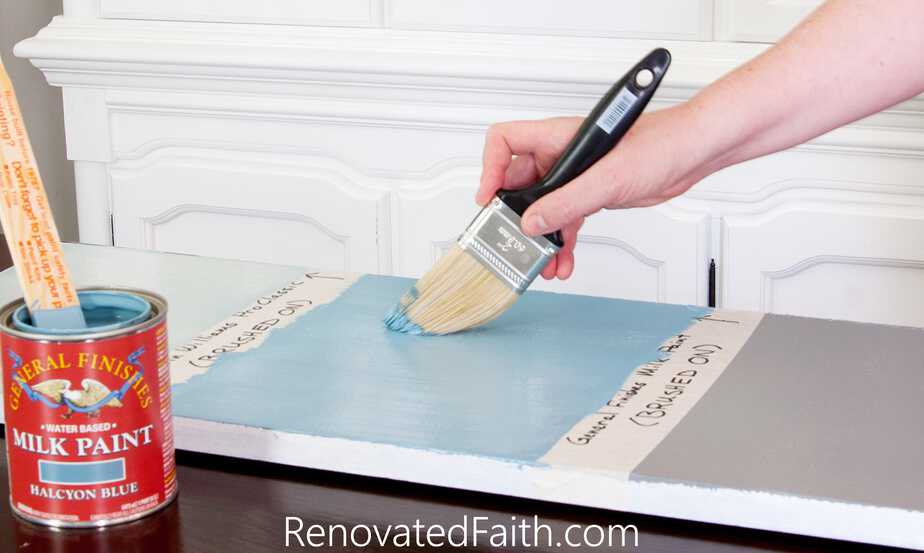
The best Milk Paint for Furniture for a Gorgeous Matte Finish
What is the best milk paint for furniture? Lately, so many furniture painters are using a product called General Finishes Milk Paint. But is it really the high-performance furniture paint so many claim or is it just the latest trend? Here is an extensive review of General Finishes Milk Paint to determine if it really lives up to all the hype.
So you decide it’s time to redo a vintage furniture piece to give it new life. When you google “the best milk paint for furniture” you get dozens of results – each claiming to have the best coverage, color options and durability. But which really is the best option for your furniture makeover?
Last week, we talked about how three of the major paint types compared in my post: Milk Paint vs. Chalk Paint vs. Latex Paint but now we want to consider how General Finishes Milk Paint stacks up!
We will be using the same ABC’s of Furniture Painting (Adhesion, Budget-Friendliness, Coverage, Durability and Ease of Use) to Compare General Finishes Milk Paint with these other three paints. (If you want to see how General Finishes Milk Paint stacks up against 24 top furniture paints, click here: The Best Paint for Furniture, 24 Top Paints Tested & Reviewed)
But why didn’t I just include GF milk paint in my discussion of milk paint in last week’s post? Because GF milk paint isn’t actually milk paint at all! Can you believe it is actually closer in composition to latex paint? <gasp!>
This is a great post for you if you:
- are a beginner furniture painter trying to find the best milk paint for that special furniture piece
- paint furniture regularly and want to see how General Finishes Milk Paint really compares to your favorite brand
- want to find out the best way to apply General Finishes Milk Paint
WANT TO REMEMBER THIS POST
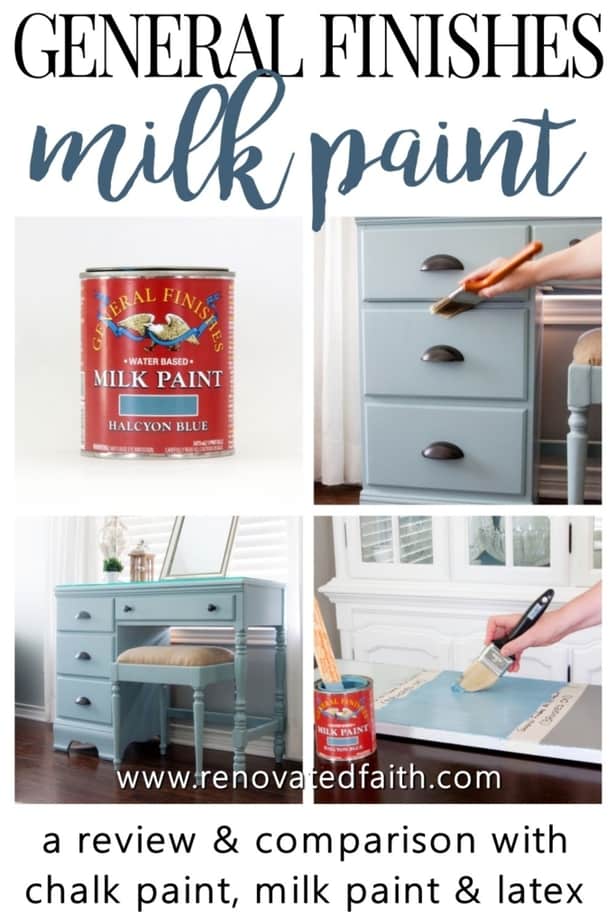
General Finishes Milk Paint
What is milk paint?
Before we discuss General Finishes Milk Paint, it is important to define terms. In my last post, I compared milk paint, chalk paint and latex paint. Milk paint has been around for years all the way back to colonial times and is known for it’s all-natural ingredients, which include limestone, clay and milk protein casein.
Traditional milk paint penetrates the layers of the wood on unfinished pieces working like a stain in many cases. Traditional milk paint allows for a lot of creativity in furniture painting because it can create an authentic, chippy look. In most cases, milk paint comes in a powdered form that has to be mixed with water and/or a bonding agent when you are ready to paint.
What is General Finishes Milk Paint?
But General Finishes Milk Paint is not really a milk paint. In fact, the only thing it has in common with milk paint is its name. It is much closer chemically to the latex paints you will find at your big box store than Miss Mustard Seed’s Milk Paint?
So why is it called milk paint?
Here is what General Finishes has to say, “GF’s Milk Paint is not a true Milk Paint – it is premixed and does not contain any casein-based ingredients. We named our product Milk Paint with the intention of putting a clear, bright, contemporary spin on an old fashioned furniture paint tradition. It is designed to mimic the low luster finish of old world paints. It is our premium paint, carefully engineered for durability, ease of application and exterior use.“
I have to admit I was a little caught off guard when I found out that there is no actual milk paint in General Finishes Milk Paint. As they say above, it is only called milk paint because the sheen and color options are similar in appearance to traditional milk paint.
But as I thought about it more, if they need to call a paint by a different name in order to get a good product in more people’s hands, then that isn’t such a bad thing!
(We will compare traditional milk paint and GF milk paint later in the post.)
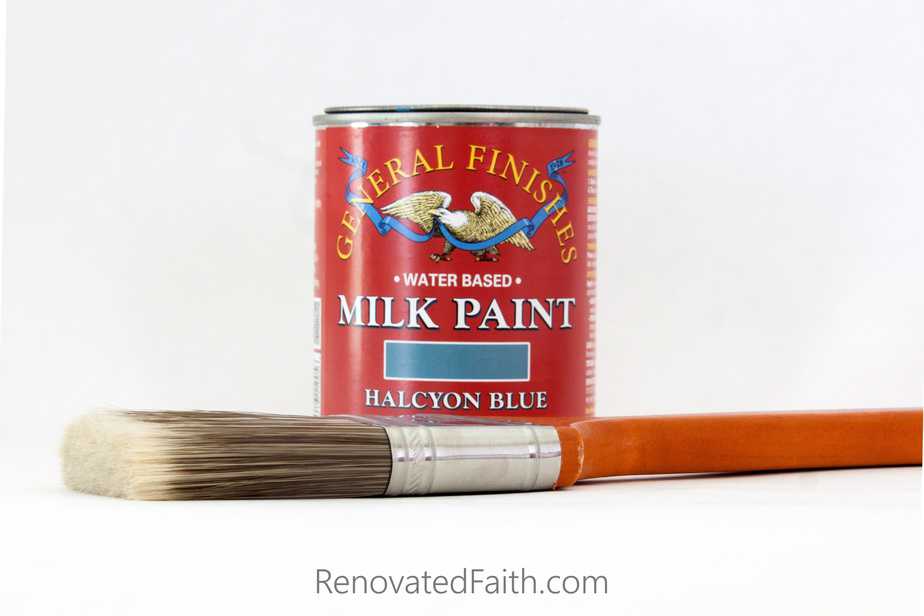
General Finishes Milk Paint is more technicially a latex (water-based) paint, using the same type of chemicals you mind find in a big box store to paint walls. Both use acrylic resins but not all acrylic resins are created equal.
General Finishes Milk Paint is a performance paint, where the acrylic latex paints in big box stores are standard latex paints. What does that mean? Basically, General Finishes uses higher quality resins and less fillers (like calcium carbonate often found in chalk paint) making it much better for furniture. In contrast, wall paint doesn’t have to be nearly as durable since walls don’t have to endure the wear and tear that furniture does.
High-quality acrylic resins give furniture pieces better overall durability, adhesion, hardness, flexibility. They also affect scrub resistance and outdoor durability. The better resins helps General Finishes Milk Paint to excel when it comes to flow, leveling and easy brushing.
Benefits of Painting with General Finishes Milk Paint
We will evaluate General Finishes Milk Paint with the same criteria we used for the other paints:
Adhesion:
An important consideration is how well General Finishes Milk Paint adheres to surfaces and what prep work is needed during the refinishing process.
Do You Have to Sand Before Using Milk Paint?
It’s a good idea to lightly sand before refinishing any furniture piece. One common misconception in redoing furniture is that you have to sand off the entire surface. However, all that’s required is to lightly sand over the surface to smooth out really rough spots, but more importantly, to rough up any slick areas so the paint adheres. To learn more about how easy sanding is, read this post: How to Sand Furniture in Less Than 5 Minutes.
Does General Finishes Milk Paint Need a Primer?
The General Finishes site says that you don’t need to use a primer except in the following circumstances: tannin bleedthrough from raw wood, bleeding from the existing finish, knots on raw wood, and it is recommended to use a dark primer when painting dark colors. Because it’s hard to know when bleedthrough can occur months and sometimes years later, we feel it is best to prime first just in case.
One of my favorite tricks is to have your primer (I like this one) tinted to a color just lighter than your paint color. This will save you on the number of coats of furniture paint because it will provide better adhesion and coverage.
Does General Finishes Milk Paint Chip?
Chipping can be a good or bad thing depending on the final result you are looking for. One of the advantages of traditional milk paint is that it can create a chippy, rustic look if you don’t use the bonding agent. General Finishes has a way to achieve this same look by using vaseline between two surfaces of paint. You can learn this technique here: Chippy Farmhouse Technique with General Finishes Milk Paint
If you want to avoid a chippy look while painting over an existing surface, we recommend using a primer first.

Budget-Friendliness:
A quart of General Finishes Milk Paint is around $29.95 on Amazon (click here to see the current price). To give you a frame of reference, here are the costs of other top furniture brands from last week’s post: Annie Sloan Chalk Paint – $34.95, Miss Mustard Seed Milk Paint – $23.00 and Sherwin Williams Advanced (Latex) is $20.36.
Where to Buy General Finishes Milk Paint – CLICK HERE
WANT TO REMEMBER THIS POST FOR LATER? CLICK HERE TO SAVE IT TO YOUR FAVORITE PINTEREST BOARD!
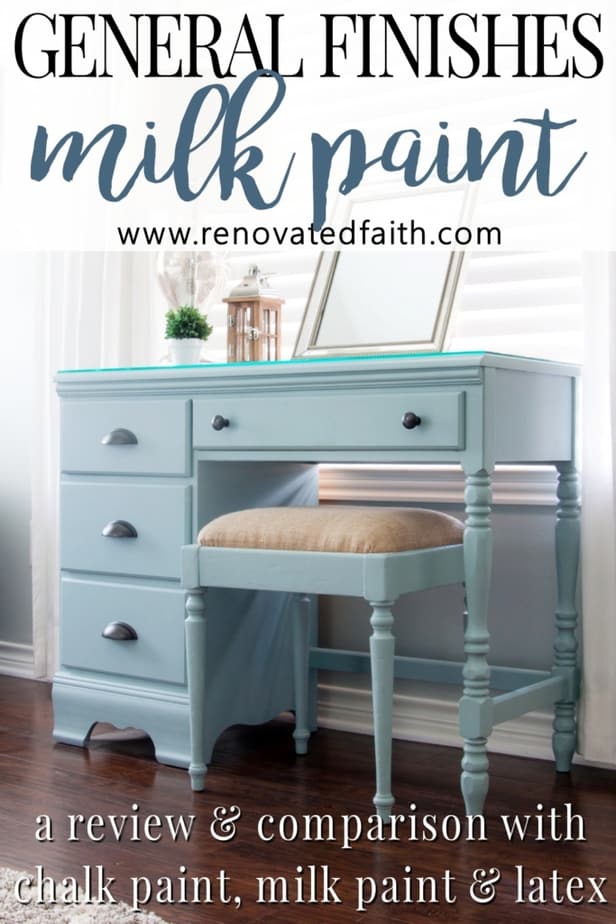
Coverage:
How Many Coats of Milk Paint Does It Take To Cover?
Two to three coats are standard but additional coats may be required when using colors with less ability to hide such as bright reds, greens, yellows and whites.
As mentioned in the video, General Finishes milk paint has the best coverage of all the other paints which included Sherwin Williams ProClassic, Annie Sloan Chalk Paint and Miss Mustard Seed’s Milk Paint.
Is General Finishes Milk Paint Self Leveling?
This milk paint levels well and brushes on very smooth when using a brush. I noticed it wasn’t quite as smooth when using a roller. Sherwin Williams ProClassic (latex) is the only paint that was smoother than General Finishes Milk Paint with the brush and roller in our tests.
Can You Distress General Finishes Milk Paint?
General Finishes Milk Paint can be easily distressed by hand but this needs to be done within 2 to three hours of application. When it comes to distressing General Finishes Milk Paint, the longer the paint dries, the harder it is to sand.
Durability: How durable is General Finishes Milk Paint?
GF milk paint is a self-sealing, exterior-rated coating with high durability and superior water and chemical resistance. It’s acrylic resins also allow it some flexibility which is needed as wood can flex and bend with temperature changes.
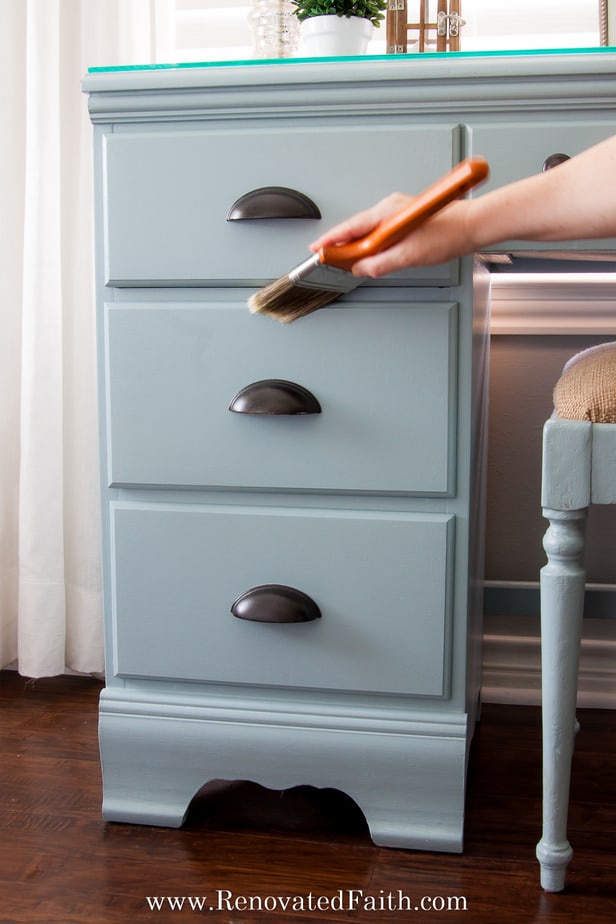
Does General Finishes Milk Paint Need a Top Coat?
General Finishes Milk Paint does not require topcoat on if your furniture surface gets low to medium wear.
However, you do want to seal high-use surfaces with three coats of top coat. These include kitchen cabinets or tabletops. Glossier sheens will provide more durability and make the surface easier to wipe clean.
What is the Best General Finishes Milk Paint Top Coat?
As I mentioned in my post The Best Top Coats for Furniture, I prefer two clear coats for sealing furniture. For most projects I use, General Finishes High Performance Top Coat in Satin but if you want a more matte sheen, you can also use General Finishes Flat Out Flat.
Ease of Use:
General Finishes Milk Paint is very easy to apply and as I mentioned in the video, I was amazed as to how it glided on. It also dries quickly and you can layer it for a more vintage look with over 30 shades to choose from.
Can you Roll General Finishes Milk Paint?
GF Milk Paint can be rolled on easily but I would suggest thinning it slighltly for a smoother finish. My favorite way to apply paint to furniture is by using a Behr Best 6 inch roller (Click Here). This finish is so smooth with this roller it looks sprayed on!
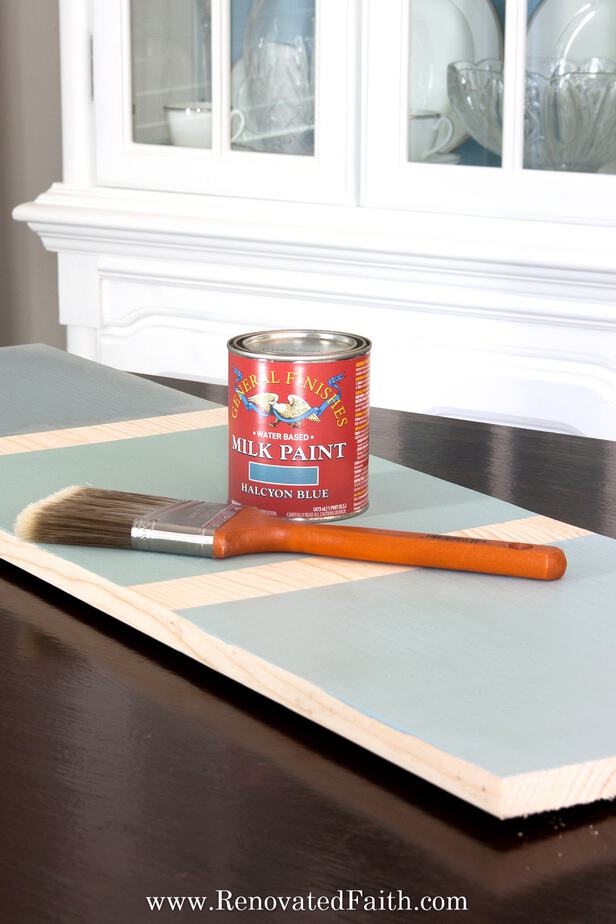
How Long Does General Finishes Milk Paint Take to Dry?
In most cases, it takes 2-3 hours for your paint to dry. Exceptions are when it is higher than 80% humidity or when 3 or more coats are used. In my last post, I discussed how all paints have a dry time and a cure time. The cure time is when the paint reaches maximum hardness.
The cure time for General Finishes Milk Paint is 21 days so use it lightly for 3 weeks until the surface hardens completely.
What is the Best Milk Paint for Furniture?
General Finishes Milk Paint Vs. Miss Mustard Seed’s Milk Paint
As we mentioned before, General Finishes milk paint is not really a milk paint at all so it stands to reason that it performs differently than traditional milk paint.
Miss Mustard Seed’s Milk Paint is made from natural ingredients including milk protein making it a true milk paint. It has to be mixed as it comes in a powder. It also requires a bonding agent if you don’t want a chippy, rustic look.
General Finishes Milk Paint is premixed and requires a primer on slick surfaces where as Miss Mustard Seed’s Milk Paint requires a bonding agent to be mixed in. GF milk paint gives a more consistent, predictable finish than traditional milk paint and will only chip if you use vaseline in between paint layers. Also, General Finishes Milk Paint is a more durable product.
In terms of sheen and color options, GF Milk Paint has 30 different colors to choose from and they have the same vintage feel as MMS’s color options. GF Milk Paint is similar in sheen to the matte look of traditional milk paint.
General Finishes Milk Paint is easier to use than Miss Mustard Seed’s Milk Paint as there is no mixing involved and you get a more consistent, durable finish. GF Milk Paint is more expensive per quart but the price is probably about the same as it covers much better than traditional milk paint.
General Finishes Milk Paint vs. Annie Sloan Chalk Paint
When comparing General Finishes Milk Paint vs. chalk paint, there are several differences. What makes chalk paint adhere well to surfaces unfortunately makes it very soft and not very durable.
For that reason, chalk painted pieces always require a top coat or wax. General Finishes is a more durable finish but in many cases, it needs a primer. However, on low to medium pieces, GF Milk Paint does not need a top coat or wax whereas chalk paint ALWAYS needs protective finish of some sort.
As I mentioned in the video, it glides on better than chalk paint and provides better coverage with less brush strokes. I also liked the matte sheen of the GF milk paint that was comparable to the Annie Sloan Chalk Paint. Both paints are about the same cost.
General Finishes Milk Paint vs. Sherwin Williams ProClassic (Latex)
For us, the real contest is General Finishes Milk Paint vs. Latex. For our latex paint, I picked a high persformance latex paint which is a water-based alklyd. It basically has a lot of the good properties of oil based paint like good coverage, lack of brush strucks and great durability. However, because it is a water-based product, it has easy clean up, low VOC’s and is not flammable.
General Finishes Milk Paint is actually a latex paint but GF milk paint is an acrylic latex and Sherwin Williams proclassic is actually an waterborn aklyd latex. In other words, the difference is in the type of resins used.
Both require a primer in most cases and both are very durable, however, Sherwin Williams ProClassic hardens to a more durable finish as a cabinet paint. General Finishes Milk Paint would need a top coat if used on cabinets or other high-use pieces.
The General Finishes has less VOC’s than most latex paints making it safer to use indoors around your family and pets.
General Finishes had much better coverage than the Sherwin Williams paint with using a roller. However, Sherwin Williams came out ahead when it came to smoothless.
In terms of cost, Sherwin Williams is almost $10 less a quart than General Finishes Milk Paint and has more color options available.
When it comes to comparing these two latex paints, they are neck and neck and you cannot go wrong with either. Both were top contenders in every category over traditional milk paint and chalk paint. What it comes down to is personal preference and whether you priority is coverage or smoothness!
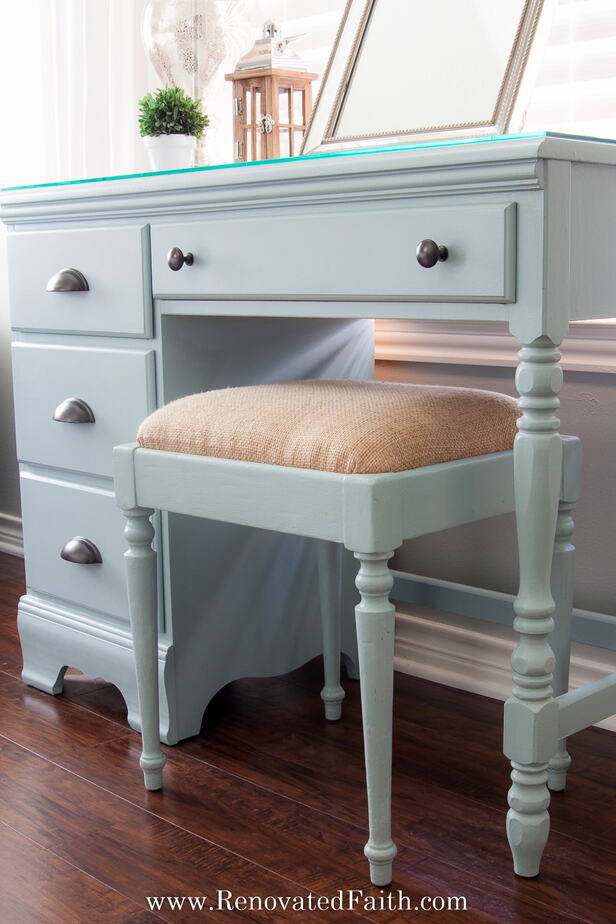
Top General Finish Milk Paint Colors
General Finishes Milk Paint comes in over 32 gorgeous colors giving you lots of options to mix and layer for the perfect finish. Click on the links below for a few of the most popular colors or click here for all color options and current prices.
Queenstown Grey
Driftwood
Coastal Blue
Seagull Gray
Snow White
Halcyon Blue
Basil
General Finishes Milk Paint: Where to Buy
Here are a couple more links to help you decide on the right color for your furniture project:
General Finishes Design Center
General Finishes Milk Paint Color Chart
Furniture Color Inspiration
The Best Way to Apply General Finishes Milk Paint
I followed the same process below for my desk in General Finishes Halcyon Blue. Here’s the before picture:
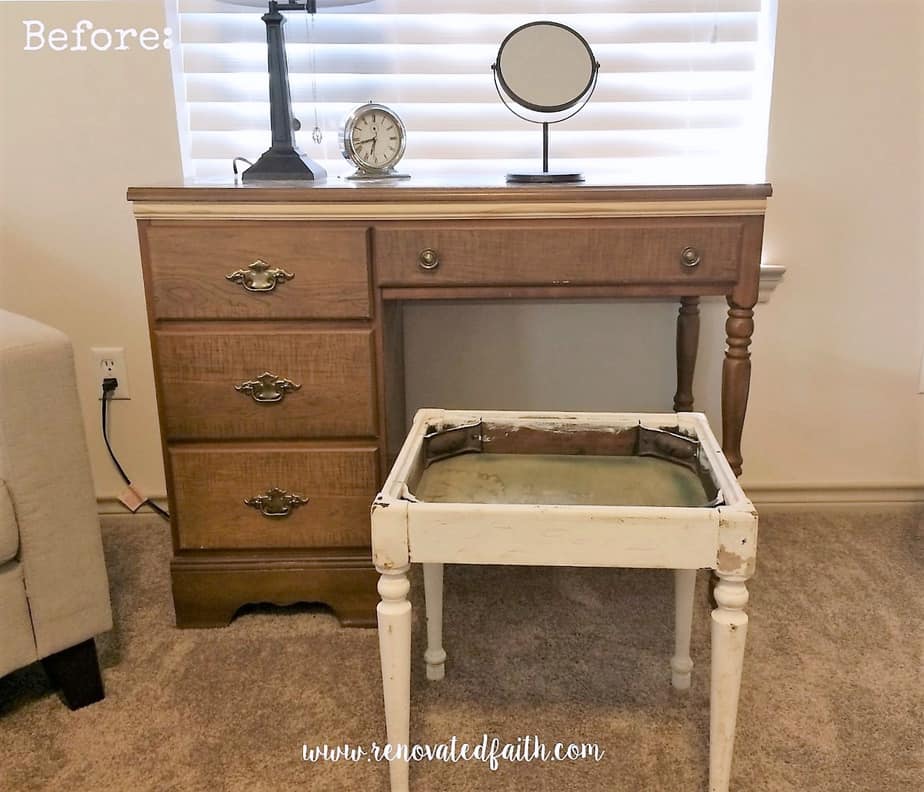
- Prep your surface by lightly sanding to help your furniture piece’s surface to accept paint. Sand with a sandpaper grit of 150.
- There are detailed instructions on the General Finishes site about properly cleaning the furniture piece for painting but you can bypass all these steps by priming it with a good primer like this one.
- After you have primed your piece, let it dry 2 hours. Now it’s time to paint. General Finishes Milk Paint can be applied with a primer or roller. Paint in long strokes with the wood grain.
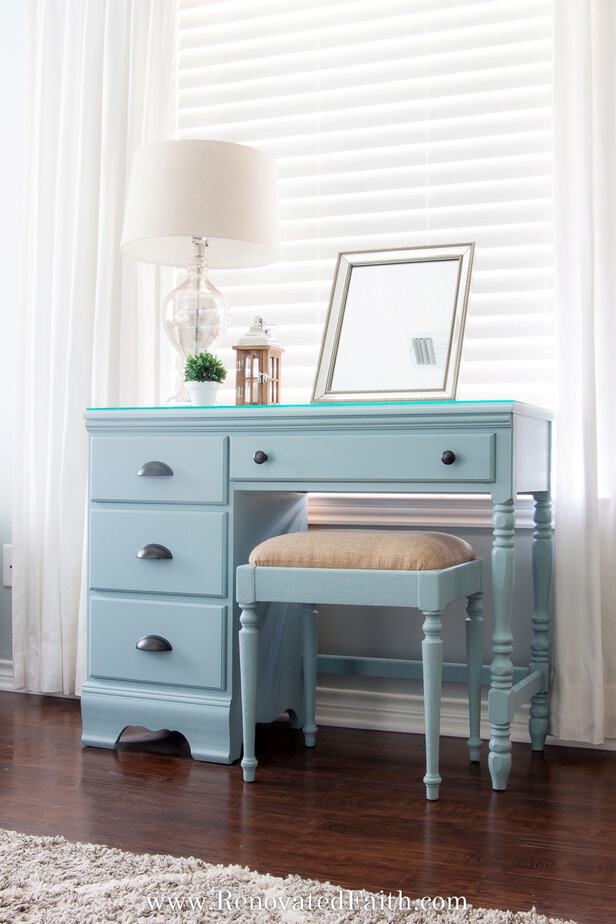
- Your piece will require at least 2 coats depending on the color. Be sure to let each coat dry at least 2 hours.
- For pieces with medium to heavy use, apply three thin layers of clear coat letting it dry at least two hours in between. I like applying top coat with a foam brush for a smooth finish.
- After you last coat of top coat has dried, be sure to use your furniture piece lightly until it has cured for 21 days.
FAQ: Reviews for General Finishes Milk Paint
Can General Finishes Milk Paint be Tinted?
Unfortunately, it can’t be tinted but it can be mixed with other milk paint colors to help you get the correct shade for your furniture project. The design center online has over a hundred different shades of colores that you can achieve by mixing General Finishes colors. You can see those color combinations here: General Finishes Color Mixing Lab
Is General Finishes Milk Paint non-toxic?
GF Milk Paint has extremely low toxicity with a VOC of 15 g/L. Here is the full MDS sheet for milk paint.
Can you Use General Finishes Milk Paint on Cabinets?
If you are wondering about painting your cabinets with General Finishes Milk Paint, that is definitely an option. Just be sure to prep and prime the cabinets and since cabinets are considered high-use, they will need three coats of a top coat.
Is Using Milk Paint as a Stain An Option?
General Finishes Milk Paint can be used as a stain but not in the traditional sense. You can do a faux stain by using this faux stain tutorial here and substituting similar shades of the General Finishes Milk Paint.
Can General Finishes Milk Paint be Used on Metal?
General Finishes Milk Paint can be used on metal as long as it is first primed with a primer appropriate for metal.
Can You Spray General Finishes Milk Paint?
Before spraying General Finishes Milk Paint on your furntiure piece, be sure to strain paint through a medium-mesh filter. For HVLP sprayers, use a 1.8mm-2.0mm spray tip and a medium air cap. Keep your gun at a 90° angle, 8 inches from the surface of your furniture piece. Overlap each pass 25% to conceal spray lines. Read here for more information on spraying techniques.
Can You Use General Finishes Milk Paint on Walls?
You definitely can use GF Milk Paint on walls but it is overkill. The resins used in General Finishes Milk Paint are more durable and flexible than what you would need for a wall making them more expensive.
Do You Need to Seal Milk Paint?
You need to seal General Finishes Milk Paint if it gets more than light use. I recommend sealing it with a General Finishes clear coat like the ones I list in this post: The Best Top Coats for Furniture.
Can You Use General Finishes Milk Paint on Laminate?
You can use General Finishes Milk Paint on laminate furniture as long as you use the right primer. Check out this post here to use the same process: How to Paint Laminate Furniture
What’s the Best Milk Paint for Furniture: YouTube Video
MUST-HAVE PAINTING TIPS:
I’ve painted a lot of furniture pieces which also means I’ve made a lot of mistakes along the way. Save yourself the time and effort by using these tricks and tips to get a fabulous finish every single time. Click here: Free Must-Have Furniture Painting Tips

Related Posts: Milk Paint by General Finishes, Reviews & Benefits
The Absolute Best Furniture Paint (24 Brands Blind-Tested & Reviewed)
Milk Paint Vs. Chalk Paint Vs. Latex
Must-Have Furniture Painting Tips
Best Clear Coats for Furniture
A Better Alternative to Chalk Paint
Why I Don’t Use Chalk Paint on Furniture
Best Tips to Paint Furniture Legs Fast
Final Thoughts: General Finishes Milk Paint Reviews and the Best Milk Paint for Furniture
So what is the best milk paint for furniture? You cannot go wrong with General Finishes Milk Paint! It is a high-performance latex in spite of the name but the color tones and sheen are reminiscent of vintage milk paint. It came out on top in terms of coverage and it’s ability to glide onto your surface. You also have several color options to choose from as the 30 base colors can be mixed with detailed instructions in the online Color Mixing Lab. General Finishes milk paint adheres well and only needs a top coat for heavy-use furniture pieces and cabinets. GF Milk Paint is a high-performance paint specifically formulated for the form and function of refinishing furniture pieces. You will be so impressed with how easy it is to apply and the stunning finish!
WANT TO REMEMBER THIS POST FOR LATER? CLICK HERE TO SAVE IT TO YOUR FAVORITE PINTEREST BOARD!
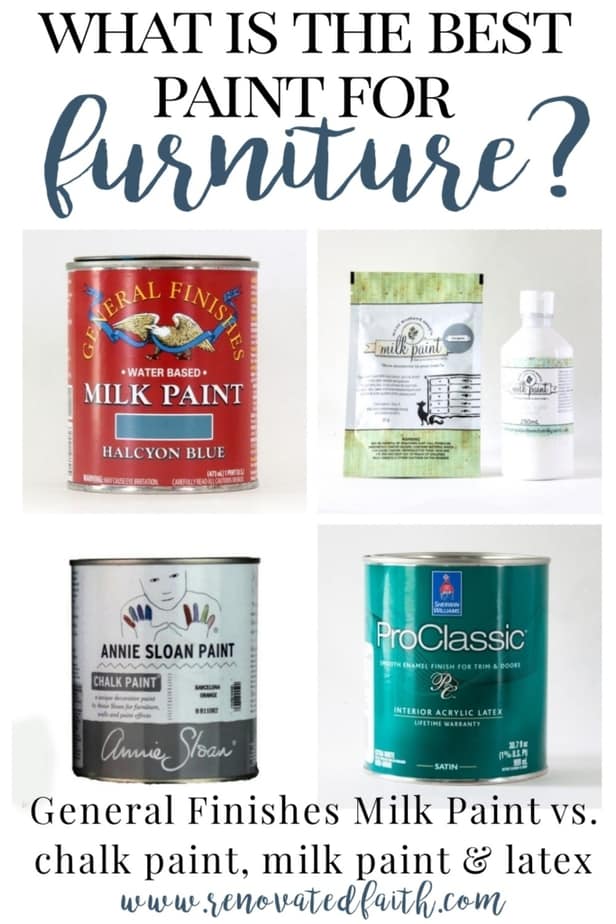
I love to hear your thoughts and questions! Scroll down to leave a comment and I WILL reply! ❤️
Blessings,

Be sure to follow the fun here!
Email Subscription | Instagram | Pinterest | Facebook | Twitter
[toc]
What is the Best Milk Paint for Furniture?
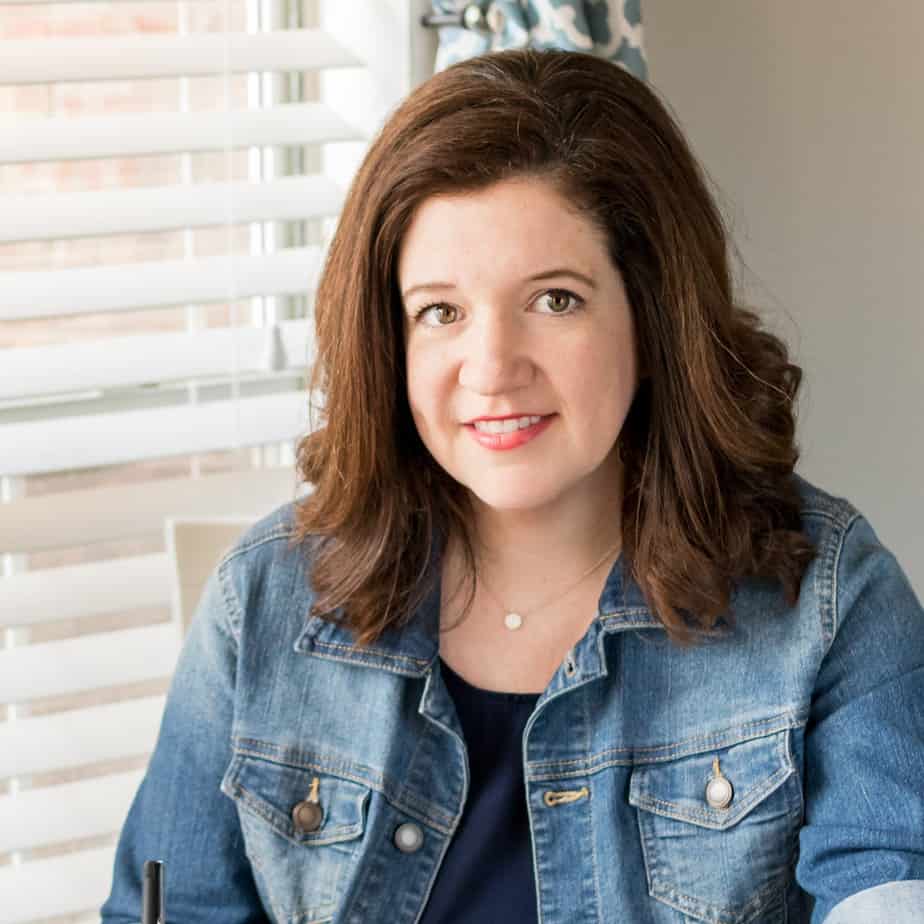
Karin Peters is a DIY expert and the creator of Renovated Faith. She is a furniture painter, a home design consultant, and a tenacious problem solver determined to help you transform your house into a home. With 17 years of experience with DIY home improvement, she researches and analyses professional processes to adapt them to be easy and cost-effective for DIYers. She then tests every project and product before it appears on the site in a detailed, step-by-step format. After attending Texas A&M University, she received her Master of Divinity with Biblical Languages at Southwestern Baptist Theology Seminary. Her passions unite in Renovated Faith, which shows readers how to create a home that serves them so they can pursue their God-given purposes. About Renovated Faith | Editorial Policy | Facebook | Twitter | LinkedIn

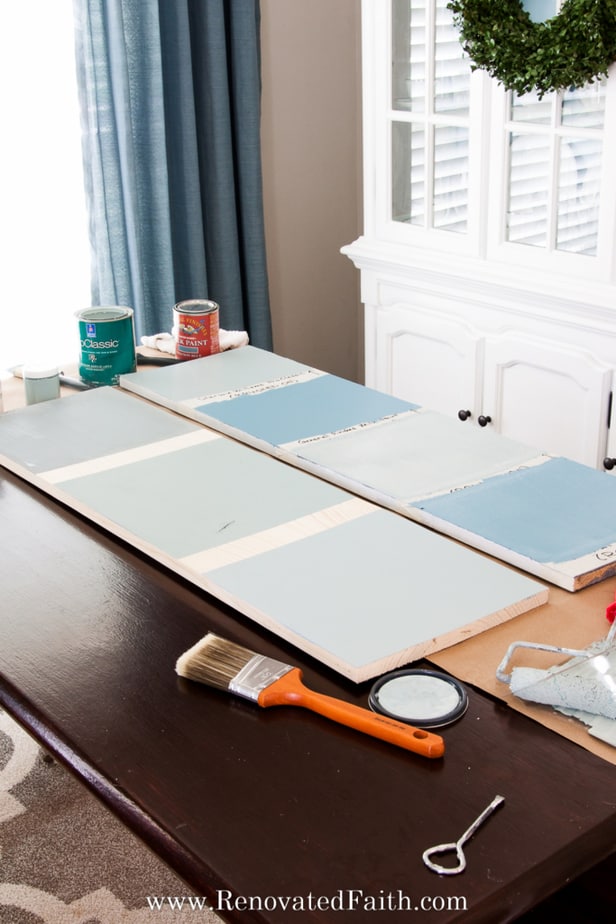

Hello Karin
First let me say your blog posts are so informative and helpful. And I truly appreciate your words of wisdom. (side note: my son-in-law also went to Southwestern Baptist Seminary in Fort Worth for his Masters). I have not read through all of the posts so forgive me if you’ve already done a post that answers my question. I need to paint a baby crib and changing table that are currently painted white. Can you recommend a type and brand of paint that is the safest for a baby crib? Also, do you think a primer is needed on the current white paint or just a light sanding for better adhesion? I appreciate any DIY guidance you can give. This project is for my first grandbaby! 🙂 Thank You!
Hey Lisa,
Please forgive me for taking so long to write back. I would use Wise Owl one-hour enamel for a crib because it is 0 VOC and will still give you a really nice finish. It also dries crazy fast. That’s so funny that your son-in-law went to SWBTS. Small world. Let me know if you have any questions about the crib and congratulations on your first grandbaby!
Excellent post.
Thanks
I’m painting three large Ikea Pax units with General Finishes Milk Paint. These units have white abs plastic finish and will be used for closet storage. Do you think sanding, priming and top coat required?
Hey Glenn, You will absolutely need to sand and prime. I know it’s a pain but five minutes of sanding can prevent you from having to redo all of them. Here is a tutorial on how to prep laminate furniture for painting: https://renovatedfaith.com/how-to-paint-ikea-furniture/
What primer and paint should i use for a solid beech wood tabletop from Ikea. I believe it came oiled. And i want to paint it white with a satin sheen.
I like Zinnser Cover Stain and Sherwin Williams ProClassic Paint. Thanks Mickie! – Karin
Hi, I’ve used the GF milk paint on my kitchen cabinets and applied 3 coats of top coat on my doors. It was sooo beautiful when it was completed but over time, it developed an ugly yellowish hue to the color. My cabinets looks awful now and am planning of redoing them. I am applying the beadboard wallpaper to it and was wondering if i can use the milk paint on it and if so, do i need to apply the top coat? I dont want it looking “dingy” again but I do have to repaint the other parts of the door that will not be covered by the wallpaper. Any suggestions? Help please!
Some clear coats can yellow over time – especially oil-based clear coats. I did a lot of testing with different clear coats (https://renovatedfaith.com/clear-coat-for-furniture/) and my favorite is Varathane’s Waterbased Polyurethane in Satin. If you use a latex paint, you don’t have to use a clear coat on cabinets. I hope this helps. Let me know if you have any questions.
What kind of fabric did you use to cover the seat?
This is actually some curtain material that I found at Target. It looks like burlap but is much softer for sitting on. I hope that helps!